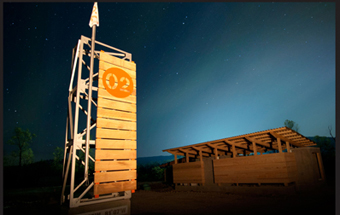Whether designed to guide people through a complex hospital building, make art more fun and accessible for museum visitors, or brand a government office, winning projects in the 2013 SEGD Global Design Awards are all working toward the same goal: providing experiences that connect people to place.
Winners in the 2013 SEGD Global Design Awards—the annual program honoring the best in environmental graphic design—range from signage for a Boy Scout camp in West Virginia to a suite of high-tech interactives at the Cleveland Museum of Art. They also include a university cafeteria in Turkey, an exhibition on Charles Dickens in New York, integrated wayfinding and placemaking for a U.S. Army Corps of Engineers office in Seattle, a research project on signage and mental mapping, and environmental graphics for a wide range of other corporate, civic, and cultural environments.
“The 2013 jury was unanimous in its conviction that excellence in environmental graphic design is communications-driven—and the best projects connect people to place in memorable ways,” says Joe Zenas, CEO and Principal of experiential design company Thinkwell Group, who chaired the 2013 SEGD Global Design Awards program.
The winning projects illustrate the dramatic impact that environmental graphic design has on the built world—and how EGD can impact the way people perceive and use public spaces, adds Zenas. “When you look at the winning projects individually and collectively, you see how design plays a major role in our everyday lives,” he says. “Our winning hospital project (pictured, above), for example, shows how providing information in a timely and sensitive way can not only reduce stress for visitors and patients, but actively contribute to the healing process.”
The 2013 winners were announced June 8 during an awards celebration at the 2013 SEGD Conference, held in San Francisco June 6-8. The jury led by Zenas selected twenty-two winning projects, including four that received the highest recognition, Honor Awards. Seventeen projects received Merit Awards and one received a Jury Award.
In addition to Zenas, the multidisciplinary jury included Chris Calori, FSEGD, Principal, Calori & Vanden-Eynden/Design Consultants (New York); Ken Carbone, Co-Founder and Chief Creative Director, Carbone Smolan Agency (New York); Phil Freelon, Founder and President, The Freelon Group (Durham, N.C.); David Harvey, Senior Vice President of Exhibition, American Museum of Natural History (New York); Cassie Hester, Designer/Illustrator and Assistant Professor at the University of West Georgia (Carrollton, Ga.), and 2012 SEGD Global Design Awards student winner; Tim McNeil, Principal, Muniz/McNeil and Professor of Design, University of California Davis; and Kevin Owens, Director, owensowens (London).
 2013 SEGD Honor Awards
2013 SEGD Honor Awards
Base Camp Charlie (pictured, left)
Boy Scouts of America Camp, Glen Jean, WV
Design: RSM Design
Federal Center South
U.S. Army Corps of Engineers office, Seattle
Design: StudioSC
Gallery One
Interactive exhibits at the Cleveland Museum of Art
Design: Local Projects
Randall Childrens Hospital
Wayfinding and graphic identity for a hospital campus, Portland, OR
Design: ZGF Architects with Mayer/Reed
2013 SEGD Merit Awards
airfield
Dynamic sculpture at Hartsfield-Jackson Atlanta International Airport
Design: UEBERSEE, Inc.
Barbie Play with Fashion
Student exhibition at the Fashion Institute of Technology, New York
Design: FIT Visual Presentation and Exhibition Design students
Bill and Melinda Gates Foundation Visitor Center
Exhibition experience focused on the Gates Foundation mission and activities, Seattle
Design: Olson Kundig Architects and Studio Matthews
Buchanan Courtyard Pavilion
Pavilion and reflecting pool installation at the University of British Columbia, Vancouver
Design: PUBLIC: Architecture + Communication
 Camden Yards (pictured, left)
Camden Yards (pictured, left)
Graphic identity at the Baltimore Orioles baseball stadium, Baltimore
Design: Ashton Design
Charles Dickens: The Key to Character
Exhibit at The New York Public Library
Design: Ann Sappenfield and Roger Westerman Design LLC
Dinosaur Hall
Exhibition program at the Natural History Museum of Los Angeles County
Design: KBDA
The Edgeless School: Design for Learning
Exhibition at The Center for Architecture, New York
Design: Hyperakt
Fake Art Museum
Graphics and environmental design for faculty canteen, Andalou University, Eskişehir, Turkey
Design: Ceyda Artun and Dilek Erdogan (environmental graphic design students)
First Day of School
Environmental graphics for Anchieta School, Porto Alegre, Brazil
Design: SCENO Environmental Graphic Design
Graphic Design + Architecture, a 20th Century History
Book on the history of environmental graphic design
Author: Richard Poulin, FSEGD
Mobius Science Center
Exhibits and environmental graphic design for interactive science center, Spokane, WA
Design: Renate
Modern Slavery: Human Trafficking in the United States
Exhibit at President Lincoln’s Cottage, Washington, D.C.
Design: Howard+Revis Design
Natural History Museum of Utah
Integrated architecture, branding, exhibition design, and wayfinding, Salt Lake City
Design: Ralph Appelbaum Associates (exhibits), Ennead (architects), GSBS (architect of record), Infinite Scale (brand), Poulin + Morris (wayfinding signage), Design Workshop (landscape design)
Olson
Branding and environmental graphics for advertising agency, Minneapolis
Design: Gensler
Play Work Build
Exhibit at the National Building Museum, Washington, D.C.
Design: Rockwell Group
Shop Life
Interactive exhibit at the Tenement Museum, New York
Design: Potion
2013 SEGD Jury Award
From Signs to Minds, Wayfinding Design and Mental Maps
Thesis project focused on wayfinding signage design using maps
Author: Michaela Skiles (Middlebury College, Middlebury, Vermont)
The winning projects, including photos, descriptions, and team credits, can be seen on the SEGD Global Design Awards archive.
About SEGD
SEGD (the Society for Environmental Graphic Design) exists to Educate, Connect, and Inspire the global, multidisciplinary community of professionals who plan, design, and build experiences that connect people to place. Through educational programs, research, and publications, SEGD’s mission is to provide learning opportunities and resources for professionals involved in creating environmental graphics, promote the importance of the discipline in establishing place, and continue to refine standards of practice for the field.
For more information, visit www.segd.org.











